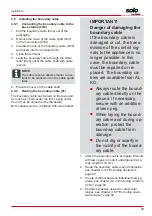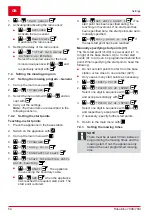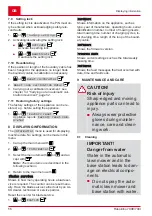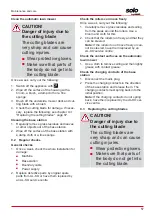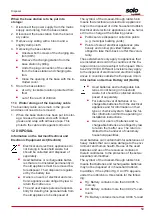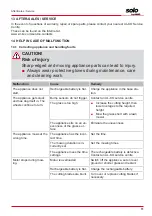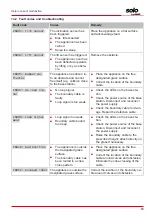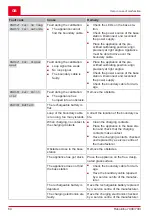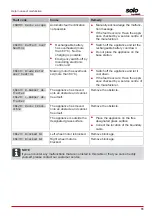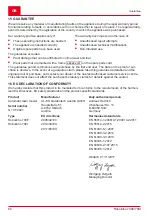
63
Help in case of malfunction
14.2 Fault codes and troubleshooting
Fault code
Cause
Remedy
CN001: Tilt sensor
The inclination sensor has
been triggered:
■
Max. tilt exceeded
■
The appliance has been
carried
■
Slope too steep
Place the appliance on a flat surface
and acknowledge fault.
CN002: Lift sensor
The lift sensor has triggered:
■
The appliance cover has
been deflected upwards
by lifting or by an obsta-
cle.
Remove the obstacle.
CN005: Bumper de-
flected
The appliance has driven in-
to an obstacle and cannot
free itself (e.g. collision close
to the base station).
■
Place the appliance on the free,
designated grass surface.
■
Correct the location of the boundary
cable.
CN007: No loop sig-
nal
■
No loop signal
■
The boundary cable is
faulty.
■
Loop signal is too weak.
■
Check the LEDs on the base sta-
tion.
■
Check the power source of the base
station. Disconnect and reconnect
the power supply.
■
Check the boundary cable for dam-
age. Repair the defective cable.
CN008: Loop signal
weak
■
Loop signal too weak
■
Boundary cable buried
too deep
■
Check the LEDs on the base sta-
tion.
■
Check the power source of the base
station. Disconnect and reconnect
the power supply.
■
Raise the boundary cable to the
prescribed height; attach directly on
the grass if necessary.
CN010: Bad position
■
The appliance is outside
the designated grass
surface.
■
The boundary cable has
been routed in a criss-
cross pattern.
■
Place the appliance on the free,
designated grass surface.
■
Correct the location of the boundary
cable around curves and obstacles.
Eliminate the criss-crossing of the
cable.
CN011: Escaped robot
The appliance is outside the
designated grass surface.
Correct the location of the boundary ca-
ble around curves and obstacles.
Summary of Contents for 127547
Page 67: ...67...

